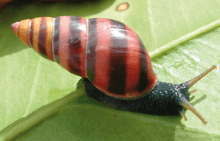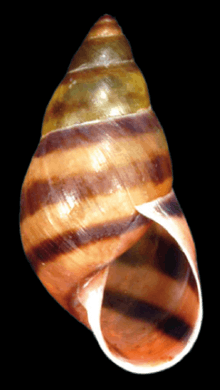Drymaeus laticinctus
| Drymaeus laticinctus | |
|---|---|
 | |
| yellow form of Drymaeus laticinctus | |
 | |
| banded form of Drymaeus laticinctus | |
| Scientific classification | |
| Kingdom: | Animalia |
| Phylum: | Mollusca |
| Class: | Gastropoda |
| (unranked): | clade Heterobranchia
clade Euthyneura |
| Superfamily: | Orthalicoidea |
| Family: | Bulimulidae |
| Subfamily: | Peltellinae |
| Genus: | Drymaeus |
| Subgenus: | Mesembrinus |
| Species: | D. laticinctus |
| Binomial name | |
| Drymaeus laticinctus (Guppy, 1868)[1] | |
| Synonyms[2] | |
| |
Drymaeus laticinctus is a species of tropical air-breathing land snail, a pulmonate gastropod mollusk in the family Bulimulidae.

Distribution
Drymaeus laticinctus is endemic to Dominica.[2] This appears to be a relatively rare species, only observed in some isolated localities.[2]
Description
There are spirally banded and unicoloured forms. In collections the colour of the latter usually fades away and becomes white, as already observed by Henry Augustus Pilsbry (1899).[2][3] His variety dominicanus of Drymaeus virginalis – a mainland taxon – appears a white specimen.[2] This species is part of the Drymaeus multifasciatus species complex, of which a revision is pending (Breure, in preparation).[2]
Ecology
Live animals were collected among fallen leaves and detritus on the ground.[2]
References
This article incorporates CC-BY-3.0 text from the reference [2]
- ↑ Guppy R. J. L. (1868). "On the terrestrial mollusks of Dominica and Grenada, with an account of some new species from Trinidad". Annals and Magazine of Natural History (4)1: 429-442. page 431.
- 1 2 3 4 5 6 7 8 Robinson D. G., Hovestadt A., Fields A. & Breure A. S. H. (July 2009). "The land Mollusca of Dominica (Lesser Antilles), with notes on some enigmatic or rare species". Zoologische Mededelingen 83 http://www.zoologischemededelingen.nl/83/nr03/a13
- 1 2 Pilsbry H. A. (1899). American Bulimulidae: North American and Antillean Drymaeus, Leiostracus, Orthalicinae and Amphibuliminae. Manual of Conchology (2)12: i-iii, 1-258, pls 1-64. page 12, pl. 12, fig. 24; page 16, plate 13, fig. 94.